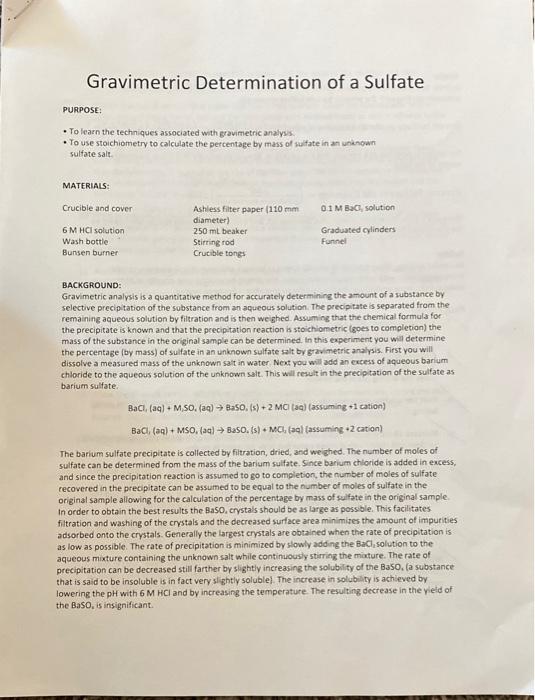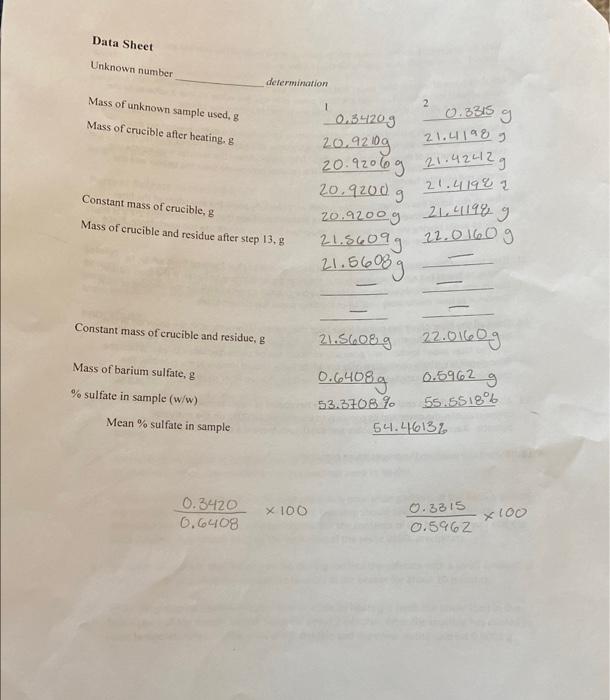The last page is all the post lab questions I need help with!
Gravimetric Determination of a Sulfate PURPOSE: - To learn the techniques associated with gravimetric analyss. - To use stoichiometry to calculate the percentage by mass of wulate in an unanown sulfate salf. BACKGROUND: Gravimetric analvsis is a quantitative method for accurately determining the amount of a substance by selective precipitation of the sobstance from an aqueous solution. The precipitate is separated from the remaining aqueous solution by filtration and is then weighed. Assuming that the chemical formula for the precipitate is known and that the precipitation reaction is stoichiometric (goes to completion) the mass of the substance in the original sample can be determined. In this experiment you wil determine the percentage (by mass) of sulfate in an unknown sulfate salt by gravimetric analysis. First you will dissolve a measured mass of the unknown sat in water Nex you will add an excess of aqueous barium chloride to the aqueous solution of the unknown salt. This will result in the precipitation of the sulfate as barium sulfate. BaCl1(aq)+M,SO,(aq)BaSO,(s)+2MCO(aa)(assuming+1cation)BaC1(aq)+MSO,(aq)BaSO,(s)+MCl4(aq)(assuming+2cation) The barium sulfate precipitate is collected by filtration, dried, and weighed. The number of moles of sulfate can be determined from the mass of the barium sulfate. Since barium chloride is added in excess, and since the precipitation reaction is assumed to go to completion, the number of moles of sulfate recovered in the precipitate can be assumed to be equal to the number of moles of sulfate in the original sample allowing for the calculation of the percentage by mass of sulfate in the original sample. In order to obtain the best results the BaSO, crystals should be as large as possible. This facilitates filtration and washing of the crystals and the decreased surlace area minimites the amount of impurities adsorbed onto the crystals. Generally the largest crystals are obtained when the rate of precipitation is as low as possible. The rate of precipitation is minimized by slowly adding the BaCli solution to the aqueous mixture containing the unknown salt while continuously stirring the mature. The rate of precipitation can be decreased still farther by slightly increasing the solubility of the BaSO, (a substance that is said to be insoluble is in fact very sl ghtly solublel. The increase in solubility is achieved by lowering the pH with 6MHCl and by increasing the temperature. The resulting decrease in the yeid of the BaSO, is insignificant. Math: In order to determine the percent sulfate in the unknown we first calculate the grams sulfate in the unknown starting with the amount barium sulfate recovered. The sulfate is reported as a percent and it is written as %(w/w) to indicate that this is a percentage by weight of the solid. Percent Sulfate in the Unknown =(manknownstartedwithg042)100 the gravimetric factor Data Sheet Unknown number delermination Mass of unknown sample used, g10.3420g20.3315g Mass of erucible after heating, g 20.9210g21.41989 20.9206g21.42429 Constant mass of crucible, g 20.9200.21.41982 Mass of crucible and residue after step 13,g21.5609g21.419gg Constant mass of crucible and residue, g21.5608g22.0160g Mass of barium sulfate, g % sulfate in sample ( w/w ) 0.640890.5962g 53.3708%55.5518% Mean % sulfate in sample 54.4613\% 0.64080.34201000.59620.3315100 Post Lab Questions: 1. Determine the percent sulfur in your unknown by using the appropriate factor to convert BaSO, to s. 2. Calculate the gravimetric factor for converting BaSO, to sulfite, SO, Hint: Set up an equation that allows you to covert BaSO, to sulfite, SOO, using the gravimetric factor 3. A sample contains some potassium sulfate K,SO, and weighs 2.000g, after reaction with barium it yielded a precipitate of BaSO, weighing 2.500g. Calculate the percent K2SO,in in the original sample. 4. What is the advantage of adding excess barium ion to a sulfate solution to precipitate the sulfate










